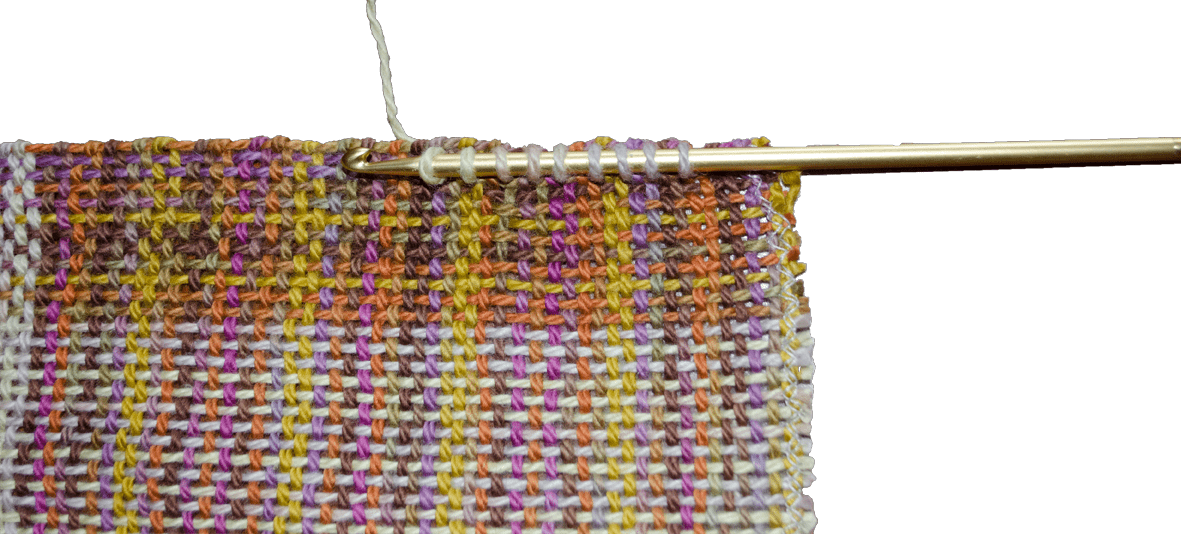By Tamara Poff
Over the last decade, I’ve formed a passion for the rigid heddle loom, encouraging hundreds of new weavers throughout the east to get started with this craft. Together, we love the affordability, portability, and quick results associated with the small, rigid heddle loom. Along the way, I am repeatedly asked, “What can I make besides scarves?” So began a mission to promote the little loom as more than an entry level tool.
To this quest, add the perspective of an avid knitter. I began looking at ways to get faster results by inserting my woven rectangles into other needle crafts. Then, there were two more creative goals to check off the list. Living in the southeastern US, I wanted to make wearable art that would be practical in our warm climate, and I wanted more contemporary design than my knitted stitch accomplished on its own.
This is my self-appointed challenge – accessible handcrafted clothing. Now add the restrictions of a small weaving space, and I am at home.
So how do we go large from our narrow, woven rectangles to obtain drape and fit in a wearable garment? This often means turning to the knitting needles for limitless possibilities, shape, drape and fit.
Picking Up Stitches Along the Woven Edge
It all starts here. I pick up a lot of stitches along the woven edge. My method to make this fast and easy is to knit a gauge swatch for the preferred stitch count, then find a crochet hook of a corresponding size with no added handle, like these shown. Hooks with a smooth round tube or a flat spot on the shaft work equally well.

With the right side of the fabric facing you, start below the first 2 ends along a selvedge. (I refer to this as “2 ends south of the border”.)
Attach your knitting yarn by pulling it through the fabric and tying a half knot to secure. You can untie this later to needle weave nicely into the fabric.
Picking up a stitch about every 2 weft picks will often get you close to the desired stitch count for garter or stockinette with only minor variance. Lacy patterns will require more space. I pick up the stitches desired, continuing with the hook for 2”. Then I hold a 2” ruler from one end of a plastic needle gauge along those stitches to check that I am making gauge, and make adjustments if necessary. You may want to mark increments along the fabric edge with locking stich markers instead to gauge achievement of your targeted number. Also, if you have a lot of stitches to pick up, you might place incremental markers onto your needle to keep track of your count as you work.

If satisfied with the count, I slide these stitches off the back end (the handle end) of the hook and directly onto my knitting needle, then repeat.
If you have that flattened thumb spot on the shaft of your hook, you need to scooch your stitches over it – no big deal.
Check your work frequently as you continue, to see that you are pulling up stitches along the same “gutter” for optimal appearance – craftsmanship! If you get to the end and determine that you need to add stitches, I’ve found that the best way is to work your knitting along the first row to a point that has a little more gap to it. Insert your crochet hook from the front, catch the yarn that was carried across that space from the pick-up row, and pull up a stitch from that. I don’t advise that you use a knitted increase into a stitch. Tried it, and I can tell you that it will show up badly.
I’ve picked up stitches along selvedge or folded (hem) edges. You won’t want to do this along a zigzagged stitched, fringe edge however, as it will likely unravel. Regardless of the loom size I work with, I maintain that adding a little knitting grants us the ultimate opportunity to refine the fit and drape of the woven piece.
This and other observations, tips, and tricks to make full garments on the little loom can be found in my new book, Woven Style for the 15” Rigid Heddle Loom, a teaching and pattern book for weavers who want to go beyond the rectangle.

